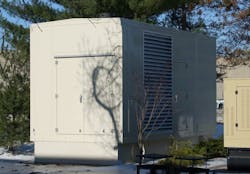Hundreds of thousands of people and buildings were left without electricity in California last year when ongoing low humidity and hot, dry winds created ideal conditions for wildfires to spread.
Utilities Pacific Gas & Electric and Southern California Edison in mid-November preemptively shut off power in parts of more than a dozen counties because sparks from aging power lines could create fast-growing fires that would be tough to control.
Nearly all Pacific Gas & Electric customers had their power restored within a day, though Southern California Edison later cautioned Santa Barbara County customers to prepare for a five- to seven-day outage due to weather conditions that create elevated wildfire risk.
Because the outages were planned, residents and facilities staffs had a little time to prepare. Many blackouts aren’t planned, however, so it’s crucial to be prepared for a sudden loss of power. Here’s what you need to know about preparing for an outage—whether or not you know it’s coming.
What Causes Blackouts and Power Outages
The California blackouts were scheduled for public safety reasons, according to the utilities. Four key factors can lead to unplanned power outages, according to Silver Run Electric, a utility that serves Delaware and New Jersey:
-
Weather. Extreme conditions like ice, wind, lightning, fires and floods can damage the electrical grid. For example, lightning might strike electrical equipment or ice could build up on power lines.
-
Accidents. Vehicle and construction accidents can damage power poles and cause the power lines to break or touch each other.
-
Trees. Utilities usually trim trees regularly to keep branches from interfering with power lines, but branches can still cause problems.
-
Grid overload. Equipment becomes overloaded on days with extreme temperatures. The system is stressed when many people are using air conditioning or electrical heating at the same time.
Protect Your Building Against Power Outages
The cost of an outage can be high. Michael Wara of the Stanford Woods Institute for the Environment estimates a $2.5 billion impact from just the preventive outages ordered by Pacific Gas & Electric, according to CNBC.
The indirect costs from outages can be high as well – in particular, the cost to your reputation. Imagine the fallout if a blackout traps people in your office’s elevator or knocks out the air conditioning in your multifamily building during a heat wave.
Charles Copeland, president and CEO of the New York consulting and engineering firm Goldman Copeland, offers these backup power purchasing tips for minimizing the next power outage’s impact on your business.
3 Backup Power Purchasing Tips
1. Define success as it relates to a blackout.
You may not be able to keep your entire building functioning during an outage, especially an extended one. But that doesn’t mean you’ve failed to prepare. For some businesses, a successful outcome might mean that the building can be evacuated quickly and efficiently, with enough backup power to keep the emergency lighting and elevator running long enough to get everyone out.
2. Figure out what equipment needs to stay on.
Which building systems do you need to achieve the best outcome? Lighting in stairs, corridors and other high-traffic spots is crucial. So is the vertical transportation if your building has more than one floor. Look at the end result you want to achieve, then work backward to figure out where to put backup power.
3. Examine your backup power options.
Use your inventory of crucial building systems to figure out the backup power capacity you’ll need. You may find out that your existing generators are no longer sufficient because your building has changed since you bought them.
Also note that your building type or location may restrict you to certain types of backup power. Batteries are popular, but it’s often not feasible to use batteries for much more than emergency lighting for evacuations or returning all elevators to the ground floor, Copeland explains. He often recommends oil-fired generators to New York-area clients.
If you decide to go that route, Copeland suggests keeping these in mind:
-
Noise. Some jurisdictions, like New York, have sound requirements in local codes. Generators can be noisy and must be tested to make sure they’re allowable.
-
Emissions. Jurisdictions with carbon emissions restrictions will have to account for the generator’s emissions when they’re calculating their building’s environmental impact.
-
Mounting options. Mounting a generator on a loading dock or the roof is typically the least expensive option, Copeland says. Your engineering firm can work with you if these two common mounting options won’t work for your situation.
-
Utility incentives. Some utilities have demand response programs that will pay you to reduce your reliance on the grid during peak usage periods. You could switch part of your building to backup power to help avoid an unplanned blackout and receive financial incentives for doing it.
An extended outage will likely still have an impact on your business, but smart planning can help you evacuate everyone safely and avoid unnecessary complications. Intelligent investments in backup power that fits your facility’s requirements ensures that you can keep the right systems running as long as necessary.
About the Author
Janelle Penny
Editor-in-Chief at BUILDINGS
Janelle Penny has been with BUILDINGS since 2010. She is a two-time FOLIO: Eddie award winner who aims to deliver practical, actionable content for building owners and facilities professionals.

